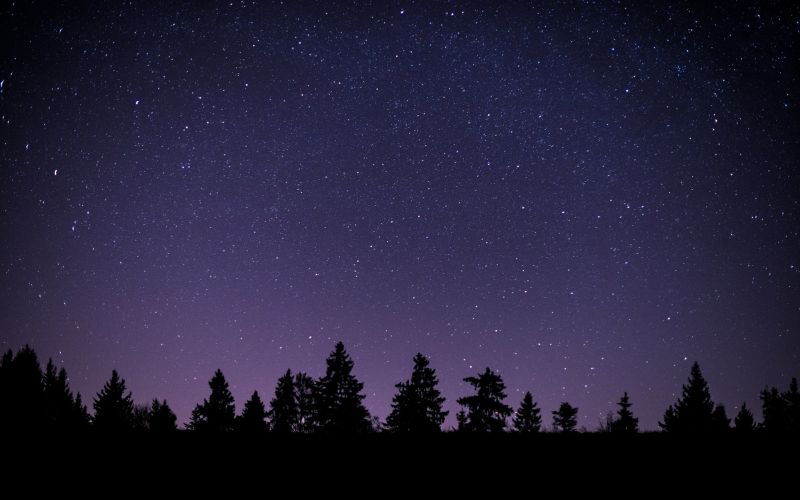
4 stunningly bright space objects visible with the naked eye in the night sky
As vibrant and beautiful as our Earth looks in the day, its night
sky looks as magnificent and enchanting. Here's bringing you a list of
bewitching night sky objects for your next stargazing night out.
1. Stars
Stars like the Sun, are massive celestial bodies made largely of hydrogen and helium, self-producing light and heat from the blazing nuclear furnaces at their centres. The stars which we can see in the sky, excluding our sun, are all light-years away from Earth; Proxima Centauri, the nearest star to it, is still 40,208,000,000,000 light-years away (or about 268,770 AU). Proxima does not appear bright to the naked eye and the reason is that Proxima Centauri is small and contains only about an eighth of our sun's mass.
Although Proxima Centauri (or Alpha Centauri) is closer to Earth, Sirius (the Dog Star) is the brightest in the night sky because Proxima Centauri is a red dwarf star (spectral type M5) with a surface temperature of 3,000 K and Sirius is a white main sequence star (spectral type A1) with a surface temperature of 9,940 K. Sirius is slightly more than twice as far away as Proxima Centauri but more than 16 times bigger and brighter.
2. Planets
There are also planetary occurrences that you can witness in the night sky, such as when Jupiter and Saturn appear closest to one another in the sky, it is a wonderful conjunction. Every 20 years or so, Jupiter "overtakes" Saturn in its orbit, resulting in the Great Conjunctions - the conjunctions of Uranus and Neptune in December 2020 and the very rare alignment of the five brilliant planets (Mercury, Venus, Mars, Jupiter, and Saturn) in the month of June 2022.
3. Andromeda galaxy
The most distant object you can see with your naked eye is the Andromeda, a spiral galaxy with an apparent magnitude of 3.44, that is roughly three times farther away than the Cassiopeia constellation (star cluster). The Andromeda Galaxy, commonly known as M31, is the one that is nearest to our galaxy, the Milky Way, and is the only galaxy that can be seen with the naked eye after ours. On a clear, moonless night, it can be seen if you know where to look and how to find it, even in areas with some light pollution. Use a high-end telescope for stargazing for a bright and satisfying experience.
Scientists believe that our Milky Way Galaxy and the Andromeda Galaxy are destined to collide with each other in about 5 billion years because of their strong gravitational pull. They predict that this collision will completely change the night sky over Earth but that the solar system will probably escape unharmed.
4. Meteor shower/ Shooting star
One of the most amazing nighttime sky phenomena to witness with the naked eye is meteor showers. As comets or asteroid encounters cause them to move in orbits around the sun, pieces of rock, iron, and ice are expelled as meteors. When the Earth travels through a comet or asteroid's trail of debris, a meteor shower follows. When meteoroids with parallel paths strike the Earth's atmosphere at very high speeds and ignite as fireballs, it creates Meteor showers, sometimes known as "shooting stars,". There are several meteor showers to witness which occur frequently in the night sky and are labelled after the constellations they appear to fall in such as Orionods, Geminids in the Gemini constellation, and Perseids in the Perseus constellation.
The Perseids meteor shower, which peaks every year between August 11 and 12, is the most noticeable since it produces more than one meteor per minute. Every year, around November 17th, the Leonid meteor shower reaches its height and with peak rates of tens of thousands of meteors per hour, the Leonid shower creates a meteor storm. Orionids, the most frequent meteor shower connected to Halley's Comet takes place yearly that lasts for about a week in late October at the constellation of Orion.
Geminids showers are slow-moving, can be observed throughout
December, and typically peak between December 4 and December 16, with the
morning of December 14 being the day with the highest intensity. The shower is
said to be getting stronger every year, with recent showers seeing 120–160
meteors per hour under ideal circumstances, typically between 2:00 and 3:30
local time.
The night sky is one of the best luxurious activities for stargazers and nature lovers as well as curious astrophile. One can also witness Space Station floating around in the night sky, weather satellites and our natural satellites, the Moon etc. In terms of discovery, we can only admire the impression of human evolution from water to land, to space, and beyond.
Disclaimer: The opinions expressed in this article are those of the author's. They do not purport to reflect the opinions or views of The Critical Script or its editor.

Newsletter!!!
Subscribe to our weekly Newsletter and stay tuned.

















Related Comments